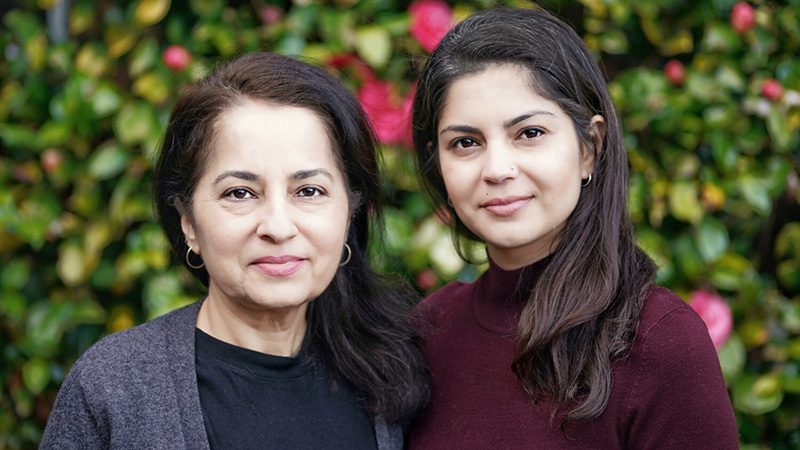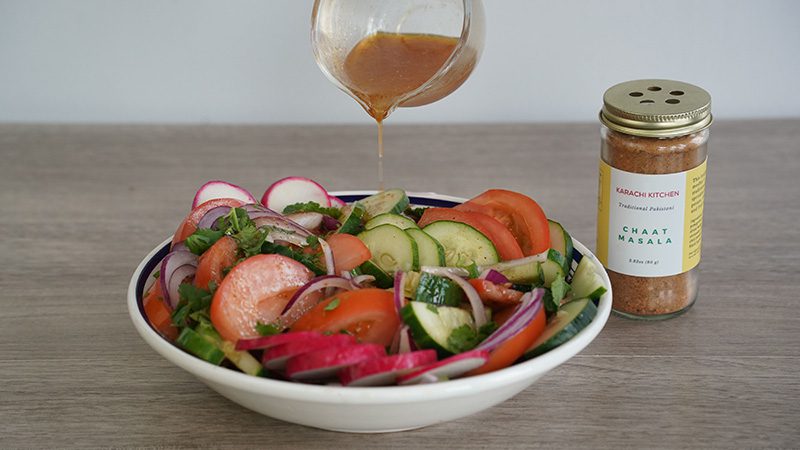Spicing up Seattle homes with the flavors of Karachi Kitchen
By Naomi Tomky, guest contributor | Photos by Scott Eaton
This article was originally published in March 2024

Kausar Ahmed had already worked as a kindergarten teacher, television producer, and Pakistan’s first professional food stylist, among a wild collection of other jobs. So, when her daughter, Sadaf, told her she should write a cookbook, she dove into the project, writing, styling, and photographing it herself. Kausar had been compiling family recipes for years, and the nudge from her daughter pushed her to formalize the process, self-publishing The Karachi Kitchen in 2017.
Today, mother and daughter both live in Seattle, along with Kausar’s mom, who personally taste tests each of the products from the pair’s Pakistani food company, Karachi Kitchen. “She is ruthless about it,” says Kausar, and her expert palate ensures their masalas carry the traditional flavors of their cuisine.
Creating Karachi Kitchen
The spice mixes—and the three-generation collaboration—evolved from the cookbook after Sadaf moved to Seattle in 2016 and discovered the region’s dearth of Pakistani cuisine. When she had left Karachi (where the family lived at the time) years earlier for college in California, she found plenty of restaurants there serving the food she remembered. “I cannot say I was deprived until I moved here,” followed later by her mother and grandmother. The idea to sell their own products came out of her hunt in Seattle for the ingredients she needed to cook Pakistani food. “I don’t think it would have happened if we were still in California.”
With Karachi Kitchen, both the book and the spice mixes, Kausar sought to tell the story of the diverse city in which she grew up through the flavors of her family’s kitchen. “I always saw food as communication,” she explains. Her own grandmother, the matriarch of her childhood home, had been a single mother of 17 and the first woman in Pakistan to open a printing press, which she did in her house. Education for all and empowering women were made clear priorities under her roof. “She would go on walks and bring back the women she met to join us for a meal,” Kausar remembers. “She would tell us, ‘We will cook something, just lay out the mat on the floor, and we all are going to be eating together, breaking bread together.’ No questions asked about who they are, what their religion is, their ethnicity.” As the youngest of the many grandchildren, Kausar took advantage of her status as the baby and the favorite, watching and helping in the kitchen whenever possible.
Her grandmother’s lessons played out in Kausar’s varied careers, which included teaching all ages of children, and then pioneering the field of food styling in Pakistan—previously any large project would simply fly in stylists from other countries. She worked on campaigns for global food brands, then produced culinary television shows. When she created a home economics curriculum for a low-income school, she fought to include boys in the courses, despite the government’s feeling that it was not useful for them. When she moved to Seattle, she continued providing culinary education as the chef-instructor at Project Feast, which provides professional kitchen training to immigrant and refugee women.
Kausar and Sadaf aim to continue their family’s legacy by turning the recipes they remember from Pakistan into Karachi Kitchen’s products. Sadaf uses her MBA from Stanford and experience in design and strategy (she currently works in marketing for the Burke Museum) to power the business, while Kausar translates quantity-less family recipes into production-scale formulas. They both taste test to make sure it meets the ideal held in their memory, but the final word comes from Kausar’s mother.

Bringing Pakistani cuisine to Seattle
As a kid, Kausar accompanied her mother to the port in Karachi to pick up fresh pomfret, a flaky, mild, white fish. Once home, her mother would marinate it in ginger, garlic, lemon juice and spice mix before deep-frying it in mustard oil. That dish served as inspiration for Karachi Kitchen’s fish masala, which evokes the same flavors with toasted cumin and cardamom, coarsely ground. “It has to have that bite,” Kausar says of the texture. To imitate the bright zing of fresh lemon, they added dried lime to the mix.
Living in Seattle, Kausar takes advantage of the local seafood, using the mix on cod and halibut, but she also uses it with red lentils and encourages people to get creative with their spices, and to play around with them, whether or not they knew much about the traditional application.
When they first started selling their spice mixes in Seattle, they found their customers had a wide range of knowledge about Pakistani cuisine. While some people were excited to find the familiar flavors, others asked basic questions, such as if it is the same as Indian food.
“We overlap,” she says, but Pakistani food has its own identity: they don’t use asafoetida and turmeric is medical, not culinary. But mostly the distinctions are less fixed and more fluid. “Every region is driven by what it grows,” Kausar explains, and her mother purchased much of their food directly from farmers, which naturally infused it with local distinctions.
Their biryani masala pulls inspiration from the other side of their family, incorporating the flavors of Bombay, where Kausar’s father came from. A chemical engineer who opened schools in Karachi, his influence makes the Karachi Kitchen biryani masala a hybrid of Sindhi and Bombay variations. The traditional dry, round red chili peppers provide the spice of Sindhi biryani, but the key to the mix comes from its balance with the other 16 spices in the mix. The smoked tandoori takes its flavor from smoking each of the spices separately, over fresh coal, to add the bright, aromatic flavor that makes vegetables, meat, or protein cooked with it truly taste like it came from a tandoor oven. It also uses a bit of their own garam masala.
“It’s a standard Pakistani garam masala,” says Kausar: warm, aromatic, and floral. “But there are as many recipes for garam masala in South Asia as there are homes.” This one is unique, though, because this is the one from her home—her Karachi Kitchen—that she wants to share with a wider audience. “It’s from the memory, we’ve had it all our life,” Kausar says. Now, filtered through her Seattle kitchen, and approved by the honed tastebuds of three generation of Karachi women, she hopes it will be a part of the memories of many more people.
Naomi Tomky (naomitomky.com), author of The Pacific Northwest Seafood Cookbook, writes about food and travel.
Cook with Karachi Kitchen
Join Kausar Ahmed of Karachi Kitchen for a PCC cooking class! In this class with Chef Kausar you’ll learn how to make the beloved and mouthwatering Seekh Kebab, made from richly spiced ground chicken or lamb wrapped around a skewer and grilled. Information and registration available here.
Karachi Kitchen at PCC
Karachi Kitchen spices are available at PCC stores in Ballard, Bellevue, Bothell, Burien, Central District, Columbia City, Edmonds, Green Lake Aurora, Green Lake Village, Issaquah, Kirkland, Redmond and West Seattle.
